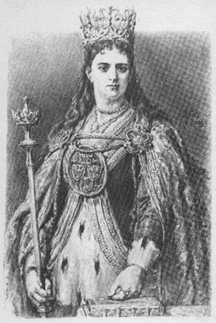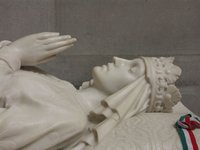Jadwiga of Poland
|
|
This article is about the 14th century queen and saint. For the 13th century saint of the same name, St. Hedwig of Andechs (Św. Jadwiga Śląska), see Hedwig of Andechs.

Queen Jadwiga (c. 1374–1399) was a Polish monarch who reigned from 1384 to 1399, venerated in the Roman Catholic Church as Saint Hedwig (Jadwiga) the Queen.
She is known as Hedwig in German, Jadvyga in Lithuanian, Hedvig in Hungarian, and Hedwigis in Latin.
| Contents |
Life
Appearance
Jadwiga was said to be a blonde, blue-eyed beauty, and an exhumation performed in 1949 showed that she was unusually tall for a medieval woman (180 cm), with no physical evidence of any deformity or disability.
Childhood
Jadwiga was most probably born on February 18, 1374. She was the youngest daughter of Louis the Great of the House of Capet-Anjou, King of Hungary and Poland, and of Elizabeth of Bosnia. Both Jadwiga's mother and Louis's mother, Elizabeth Łokietkówna, were descended from the House of Piasts, the ancient native Polish dynasty. Jadwiga was a great-granddaughter of King Ladislaus the Short, who had reunited Poland in 1320.
Jadwiga was brought up at the royal court in Buda. In 1378 she was betrothed to the Habsburg scion William of Austria and spent about a year at the imperial court in Vienna. Their engagement was broken off and he married, after Jadwiga's death, her cousin Joan II of Naples. Jadwiga's father had also made an arrangement with Sigismund of Luxemburg, the future Holy Roman Emperor, for the latter to marry either Jadwiga or her sister Mary (Sigismund eventually married Mary).
Jadwiga was well educated and a polyglot, interested in arts, music, science, and court life. She was also known for her piety and her admiration for Saints Mary, Martha, and Bridget of Sweden, as well as her patron saint, Hedwig of Andechs.
Reign
Until rather recently, Poland had been ruled by her independent king Casimir III of Poland, of the ancient Piast dynasty. He had arranged, sonless and deeming his own descendants either unsuitable to inherit or too young, that his surviving sister Elisabeth of Poland and her son, Louis I of Hungary, should succeed him in Poland. Louis had been proclaimed king, and Elisabeth held much of the practical power until her death in 1380.
When Louis died in 1382, the Hungarian throne was inherited by Mary. In Poland, however, the lords of Lesser Poland (the virtual rulers of Poland) did not want to continue the personal union with Hungary, nor to accept Mary's fiancé Sigismund as a regent. They therefore chose Mary's younger sister, Jadwiga, as their new monarch. After two years of negotiations with Jadwiga's mother, Dowager Queen Elisabeth of Hungary (Elisabeth of Bosnia) who was regent of Hungary, and a civil war in Greater Poland (1383), Jadwiga finally came to Kraków and was crowned King (sic) of Poland on November 16, 1384, Hedvig Rex Polonić, not Hevig Regina Polonić. The masculine gender in her title was intended to underline the fact that she was a monarch in her own right, not a queen consort.
As child monarch of Poland, Jadwiga had at least one relative in Poland (all her immediate family remained in Hungary): her mother's uncle Vladislav of Kujavia (d. 1388), Prince of of Gniewkowo. He was childless.
Soon after her coronation, new pretenders to Jadwiga's hand appeared: Duke Siemowit IV of Masovia and Grand Duke Jogaila (Jagiełło) of Lithuania, the latter supported by the lords of Lesser Poland. In 1385 (when Jadwiga was eleven years old) William Habsburg came to Kraków to consummate the marriage and present the lords with a fait accompli. His plan, however, failed and William was expelled from Poland while Polish bishops declared his engagement to Jadwiga invalid. In the same year Jogaila and the lords of Lesser Poland signed the Union of Krewo in which Jogaila pledged to adopt Latin Christianity and unite Lithuania with Poland in exchange for Jadwiga's hand and the Polish crown. Jadwiga (12) and Jogaila (36) — who had earlier been baptized Ladislaus — were wed in March 1386 in Kraków. This was followed by Jogaila's coronation as king of Poland, although Jadwiga retained her royal rights. In 1387, Jadwiga's mother Elisabeth was strangled by the Horvathy supporters of her rival in Hungary.
As a monarch, Jadwiga probably had very little actual power. Nevertheless, she was actively engaged in her kingdom's political, diplomatic and cultural life. In 1387 she led a military expedition to reconquer the Duchy of Halych and in 1390 she began to correspond with the Teutonic Knights. She had many Latin books translated into Polish for her. She also donated much of her wealth to charity, including the foundation of hospitals. Among Jadwiga's accomplishments was the founding of a bishopric in Vilnius. Most of all, she donated her jewelry, dresses — and even her royal insignia — to restore the Academy of Kraków, since called Jagiellonian University in honor of her and her husband.
Death and inheritance
On June 22, 1399 Jadwiga gave birth to a daughter, baptized Elizabeth Bonifacia. Within a month, both the girl and her mother had died from birth complications. Jadwiga died on July 17, 1399. She was buried together with her baby in Wawel Cathedral. Her death undermined Jogaila's position as King of Poland, but he managed to retain the throne until his death 35 years later.
It is not easy to state who was Jadwiga's heir in line of Poland, or Poland's rightful heir, since Poland had not used primogeniture, but kings had ascended by some sort of election. Descendants of Vladislav the Short (through Silesian dukes of Swidnica) included the then Emperor Venceslas, who died without issue in 1419, as well as Silesian dukes of Opole and Sagan. And there were descendants of superseded daughters of Casimir III of Poland (d. 1370), such as his youngest daughter Anna, Countess of Celje (d. 1425 without surviving issue), and her daughter Anna of Celje (1380–1416) whom Vladislav Jagello married next but who also died childless. Emperor Sigismund himself was a heir of Casimir III, as eldest son of his mother Elisabeth of Pomerania, who was since 1377 the only surviving child of Elisabeth of Poland, herself the younger but only progenited daughter of Casimir III from his first marriage with Gediminaitis Aldona of Lithuania. The family possession of the principality of Kujavia belonged to Sigismund, who was the heir with the strongest hereditary claims. However, the leaders of the country wanted to avoid Sigismund and any personal union with Hungary.
Jadwiga's husband Vladislav Jagello kept her kingdom, and mostly because no claimant with clearly better stature appeared, he was never ousted, not even after the death of his second wife. He was eventually succeeded in Poland by sons of his last wife, who were not related to the earlier Polish rulers.
Template:Kings and Dukes of Poland
Legends and veneration
| Saint Hedwig the Queen | |
|---|---|
| Confessor | |
| Born | Buda, February 18, 1374 |
| Died | Kraków, July 17, 1399 |
| Venerated in | Roman Catholic Church |
| Beatified | Kraków, August 8, 1986 |
| Canonized | Kraków, June 8, 1997 |
| Major shrine | Wawel Cathedral, Kraków |
| Feast | July 17 |
| Attributes | Royal dress and shoes |
| Patronage | Queens, united Europe |
Legends
From the time of her death, Jadwiga was widely considered a saint. Numerous legends alleging miracles were recounted to justify her sainthood. The two best known are those of Jadwiga's cross and Jadwiga's foot.
Jadwiga often prayed in front of a large black crucifix hanging in the northern aisle of Wawel Cathedral. Christ hanging on the cross is said to have spoken to her during one of these prayers. The crucifix, often called "Saint Jadwiga's cross", is still there, with Jadwiga's relics placed below.
According to another legend, Jadwiga took a piece of jewelry from her foot and gave it to a poor stonemason who had begged her for help. When the queen left, he noticed her footprint in the plaster. Her alleged footprint, known as "Jadwiga's foot", can be still seen in one of Kraków's churches.
Exhumations and sarcophagus
Jadwiga's body was exhumed at least three times. The first time was in the 17th century, for the purpose of construction of a bishop's sarcophagus next to Jadwiga's grave. The next exhumation took place in 1887. Jadwiga's complete skeleton together with a mantle and a hat were found. Jan Matejko made a sketch of Jadwiga's skull, which later helped him to paint her portrait (see above).
On July 12, 1949 her grave was opened again. This time Jadwiga was buried in a new sarcophagus founded by Karol Lanckoroński and sculpted in white marble by Antoni Madeyski in 1902. The queen is depicted with a dog, a symbol of fidelity, at her feet. The sarcophagus is oriented with Jadwiga's feet pointing westwards, unlike all other sarcophagi in the cathedral. Next to the sarcophagus, a wooden orb and scepter, symbols of the queen's modesty and charity, are on display.
Veneration
Despite widespread veneration for Jadwiga in Poland, it was only on June 8, 1979 that Pope John Paul II prayed at her sarcophagus, and the Congregation for Divine Worship and the Discipline of the Sacraments officially affirmed her beatification on August 8, 1986. The Pope finally canonized her in Kraków on June 8, 1997.

